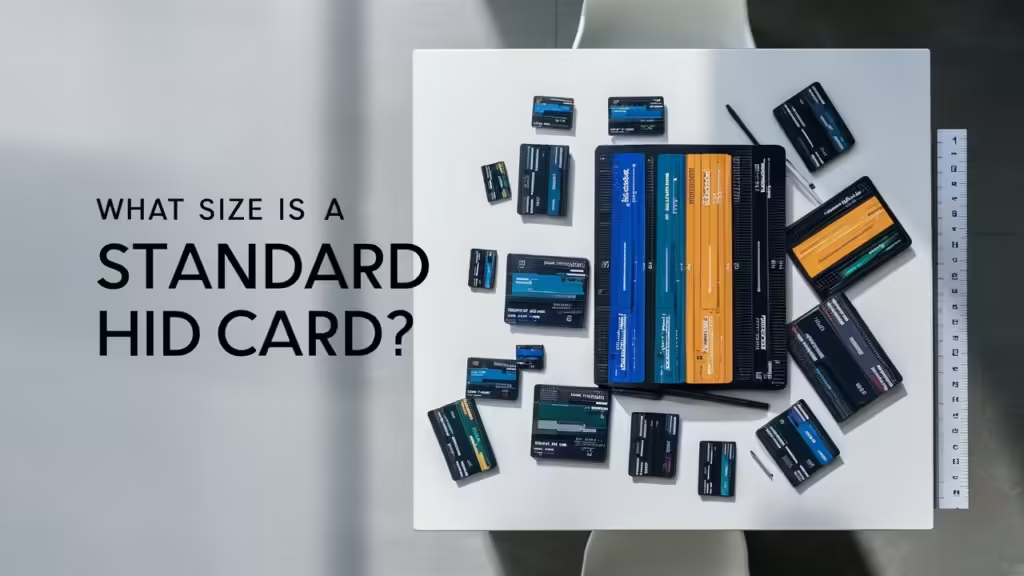When it comes to access control and identification systems, one of the most popular products is the HID prox card, which comes in various formats. But have you ever wondered about the specifics of these cards, particularly their size?
The size of an HID card may seem like a trivial detail, but it’s a crucial factor that influences everything from the card’s compatibility with various readers to its ease of use and storage. For security professionals, facility managers, and even end-users, understanding the standard dimensions of HID cards is more important than you might think.
Standard HID Card Dimensions
The most common HID card size follows the CR80 standard, which is also used for credit cards and many other types of identification cards. The dimensions of a standard CR80 HID card are:
| Measurement | Inches | Millimeters |
| Width | 3.375 | 85.6 |
| Height | 2.125 | 54 |
| Thickness | 0.030 | 0.76 |
These dimensions are consistent across various HID card types, including the popular prox card II HID model. The CR80 size has become an industry standard due to its compatibility with a wide range of card readers, printers, and other access control equipment. However, there can be slight variations in thickness depending on the specific card type and any additional features, such as embedded chips or magnetic stripes.
Types of HID Cards and Their Sizes
HID Global offers various types of proximity cards, each designed for specific applications. While most adhere to the CR80 standard, some variations exist:
- Standard Proximity Cards: These include the HID proxcard 2, which follows the CR80 dimensions mentioned above.
- Clamshell Cards: Slightly thicker than standard cards, typically measuring 0.065 inches (1.65 mm) in thickness.
- ISO Thin Cards: Designed to be more flexible and durable, with a thickness of 0.031 inches (0.79 mm).
- Key Fobs: These are not card-shaped but are small, typically measuring about 1.9 inches (48 mm) in length and 1.2 inches (30 mm) in width.
- Adhesive Tags: Small, round tags that can be affixed to other objects, usually about 1.3 inches (33 mm) in diameter.
Read More Articles: The Best Views from Wineries in Barossa Valley
Factors Influencing Card Size Selection
When choosing HID cards for an access control system, several factors should be considered:
- Compatibility with existing hardware
- Desired read range
- Need for visual identification
- Requirement for multiple technologies (e.g., proximity and smart card)
- Durability and usage environment
26 Bit Proximity Cards are a popular choice for many organizations due to their versatility and compatibility with a wide range of systems. These cards use a specific data format that includes a facility code and a unique ID number, all within the standard CR80 size.
Printing and Customization Considerations
The standard size of HID cards allows for easy customization and printing. Organizations can add:
- Company logos
- Employee photos
- Barcodes or QR codes
- Text information (name, ID number, etc.)
When designing card layouts, it’s important to account for any embedded antennas or chips that may limit the printable area. A Proximity card supplier often provides templates and guidelines for effective card design within the standard dimensions.
Compatibility with Card Readers
The CR80 size ensures that standard HID cards are compatible with most card readers in the market. However, it’s crucial to verify compatibility when:
- Upgrading an existing system
- Mixing different types of cards (e.g., proximity and smart cards)
- Using cards from multiple manufacturers
Some specialized applications may require readers designed for non-standard card sizes or form factors.
Trends in Card Sizes
While the CR80 size remains the industry standard, emerging trends in access control technology may influence future card sizes:
- Increased adoption of mobile credentials
- Integration of multiple technologies in a single card
- Development of ultra-thin cards for improved durability
Despite these trends, the CR80 size is likely to remain dominant due to its widespread adoption and the significant investment in compatible infrastructure.
Read More Articles: Best Time to Visit Barossa Valley Wineries
The Impact of HID Card Sizes on Multi-Technology Integration
As access control systems become increasingly sophisticated, the demand for cards that can support multiple technologies has grown. The standard size of HID cards plays a crucial role in facilitating this integration. The CR80 format provides enough space to incorporate various technologies without compromising the card’s usability or durability.
Multi-technology cards often combine:
- Proximity technology (like that used in the HID proxcard 2)
- Smart card capabilities
- Magnetic stripes
- Visual security elements (holograms, UV printing)
The challenge for proximity card suppliers and manufacturers is to pack all these technologies into a card that maintains the standard dimensions. This is where the importance of the CR80 size becomes evident. Its surface area allows for the inclusion of multiple antennae and chips, while its thickness can accommodate various embedded technologies.
For example, a single HID card might include:
- Low-frequency proximity technology for basic access control
- High-frequency smart card technology for secure data storage
- A magnetic stripe for legacy systems
- Printed information and security features on the surface
All of these elements must fit within the 3.375″ x 2.125″ x 0.030″ dimensions of a standard card. This standardization ensures that multi-technology cards remain compatible with a wide range of readers and systems.
HID Cards in a Changing World
Understanding the standard size of HID cards is essential for organizations implementing or managing access control systems. The CR80 dimensions (3.375″ x 2.125″ x 0.030″) have become the de facto standard for HID prox cards. This standardization ensures compatibility across a wide range of systems and allows for easy customization and printing. Organizations should consider their specific needs, existing infrastructure, and future scalability when selecting card types and sizes for their access control systems.
When it comes to secure, high-quality HID cards and custom identification solutions, look no further than Bristol ID Technologies. Our high-end manufacturing facilities ensure that every card meets the highest standards of quality and security. We understand that one size doesn’t fit all, that’s why we offer customized solutions tailored to your specific needs.


